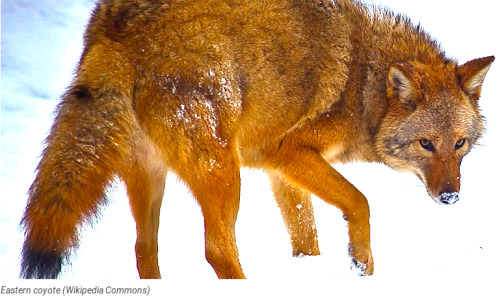mutat-nilpoj:vastderp:actuallyclintbarton:geekhyena:thewinterotter:animalsandtrees:A new species is
mutat-nilpoj:vastderp:actuallyclintbarton:geekhyena:thewinterotter:animalsandtrees:A new species is evolving before scientists’ eyes in the eastern United States.Wolves faced with a diminishing number of potential mates are lowering their standards and mating with other, similar species, reported The Economist.The interbreeding began up to 200 years ago, as European settlers pushed into southern Ontario and cleared the animal’s habitat for farming and killed a large number of the wolves that lived there.That also allowed coyotes to spread from the prairies, and the white farmers brought dogs into the region.Over time, wolves began mating with their new, genetically similar neighbors.The resulting offspring — which has been called the eastern coyote or, to some, the “coywolf” — now number in the millions, according to researchers at North Carolina State University.Interspecies-bred animals are typically less vigorous than their parents, The Economist reported — if the offspring survive at all.That’s not the case at all with the wolf-coyote-dog hybrid, which has developed into a sum greater than the whole of its parts.At about 55 pounds, the hybrid animal is about twice as heavy as a standard coyote, and her large jaws, faster legs and muscular body allow her to take down small deer and even hunt moose in packs, and the animal is skilled at hunting in both open terrain and dense woodland.An analysis of 437 hybrid animals found that coyote DNA dominates her genetic makeup, with about one-tenth of its DNA from dogs, usually larger dogs such as Doberman pinschers and German shepherds, and a quarter from wolves.The animal’s cry starts out as a deep-pitched wolf howl that morphs into higher-pitched yipping — like a coyote.Her dog DNA may carry an additional advantage.Some scientists think the hybrid animal is able to adapt to city life — which neither coyotes or wolves have managed to do on their own — because her dog ancestry allows her to tolerate people and noise.The coywolves have spread into some of the nation’s largest cities — including New York, Boston and Washington — using railway corridors.The interbreeding allows the animal to diversify her diet and eat discarded food, along with rodents and smaller mammals — including cats, which coywolves eat skull and all — and they have evolved to become nocturnal to avoid humans.The animals are also smart enough to learn to look both ways before crossing roads.Not all researchers agree the animal is a distinct species, arguing that one species does not interbreed with another — although the hybrid’s existence raises the question of whether wolves and coyotes are distinct species in the first place.But scientists who have studied the animal say the mixing of genes has been much faster, extensive and transformational than anyone had noticed until fairly recently.“(This) amazing contemporary evolution story (is) happening right underneath our nose,” said Roland Kays, a researcher at North Carolina State.Watch this report on coywolves.Raw StoryTHIS SHIT IS SO WILD AND IT’S ABSOLUTELY FASCINATING. If you’d like to watch the entire Nature documentary referenced in that “watch this report” link, you can find the whole thing on Youtube. It’s a terrific documentary and a really interesting look at an animal most people don’t even seem to realize exists. The extent to which coywolves have adapted to urban life and the ways in which they’re very distinct from the species they’ve sprung from is pretty incredible.NEEEEEATThe documentary (”Meet the Coywolf”) is also currently on Netflix and it’s really interesting!yeeeeI watched it. It’s a really cool thing. Go watch nature! -- source link
Tumblr Blog : animalsandtrees.tumblr.com
#mugglefucking science

